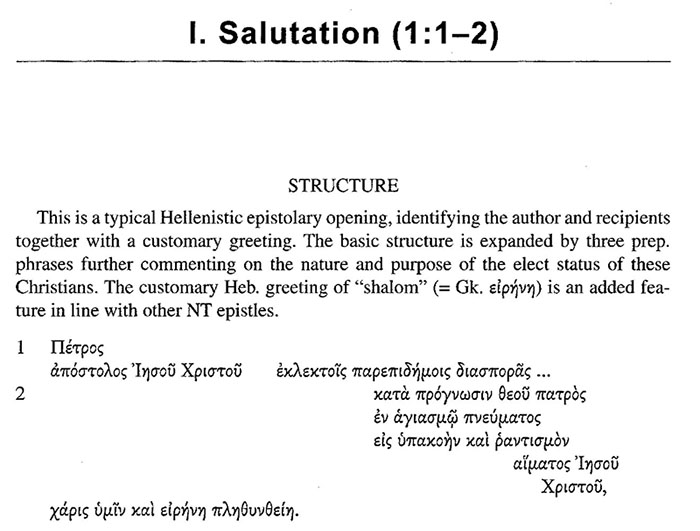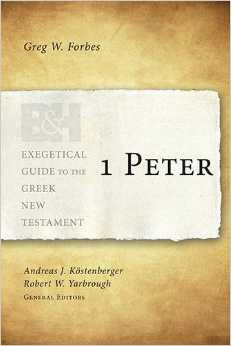Reviewed by Fred G. Zaspel
Different commentaries come with different strengths, of course, but certainly none can be more profitable to the preacher or the teacher than those which help us gain a closer understanding of the biblical text itself. This, in brief, is the value of this new Exegetical Guide to the Greek New Testament (EGGNT) series from B&H. Throughout the books the authors provide homiletical suggestions that are very helpful, as well as other valuable material. But what distinguishes them is their laser-focus on the biblical text itself, guiding the reader, paragraph by paragraph, line by line, phrase by phrase, through the unfolding thoughts of the inspired text.
The approach is straightforward. First there is the basic introductory material (authorship, date, setting, etc.) and a brief outline of the book. The main body of the book consists in a paragraph by paragraph and phrase by phrase analysis of the biblical text (see below). The comments are brief and concise yet insightful, reflecting a clear grasp of informed exegetical method, guiding the reader carefully through the unfolding thought of the biblical text. The commentary then concludes with a comprehensive exegetical outline of the entire epistle.
In both of these EGGNT commentaries (James and 1 Peter) the authors begin discussion of each next paragraph with a structural overview of those verses. Forbes presents the structure of each paragraph of 1 Peter visually so that at a glance the reader can grasp the flow of thought, as in the sample below.

These paragraph structural overviews are followed by 1) a phrase-by-phrase examination of words, grammar, and syntax and their significance in that sentence or paragraph; 2) a bibliography (“For Further Study”) of specialized studies in the issues addressed in that paragraph; and finally 3) a brief outline (“Homiletical Suggestions”) that summarizes the thought of the paragraph. In the end a concise yet comprehensive understanding of the paragraph is given in the space of only a few pages, and the reader is well on his way to a closer grasp of it.
The homiletical suggestions are only very brief, and although they may not often become the preacher’s own sermon outline they are helpful in steering the preacher to think closely with the flow of the text so that he will craft his sermon accordingly. The specific bibliographies for each paragraph are excellent for those who wish to pursue further specialized studies that arise in the text (for example the “dispersion” of 1 Pet. 1:1 or “the mirror metaphor” in James 1:22-24). Extended theological reflection is rarely offered, yet exegesis of Scripture is necessarily a theological task also. So for example, on James’ often debated question, “Was not Abraham our father justified by works?” (James 2:21), Vlachos offers three understandings of δικαιόω that are viable here, briefly summarizing the supporting evidence for each. He leaves the decision to the reader, but he also reminds us at the end of this controversial section that the “faith” under discussion is a faith that is merely “claimed” (as per v.14; pp.95-101). So also in his analysis of Peter’s statement that “baptism saves” (1 Pet. 3:21), Forbes leads us through the exegetical options but draws conclusions that are informed by the larger NT soteriology (p.126-131).
But again, the strength of the EGGNT commentaries is the careful guide through the biblical text that they provide, tracking the thought of the inspired writers paragraph by paragraph and phrase by phrase. It is simple, straightforward exegesis. Larger theological and homiletical unpacking are left to the reader and to other commentaries; here the focus is on first things – what the biblical author said.
The EGGNT commentaries assume an intermediate knowledge of Greek, but they have much to offer students of every level. Even the beginning student unacquainted with some of the technical jargon will learn the “how to” of biblical exegesis and profit from the model of exegetical analysis that is basic to all biblical study. Intermediate students also will also find their exegetical eyes and skills sharpened. And even the professional scholar will profit from the mature exegetical reflections spelled out here. These books do what we all should do in our sermon and lesson preparation – and (presumably) would, if only we could. For the busy pastor in particular, who feels the strain of time yet wants to maintain his exegetical skills and be faithful to the text he preaches, these guides are a resource of the first rank. In their sermon preparation many faithful preachers labor conscientiously first to acquaint themselves thoroughly with the biblical text and only then go to the commentaries. These are well-suited to be the first commentaries to consult in that process.
The Exegetical Guide to the Greek New Testament series is a projected 20 volume work. James by Chris Vlachos (PhD program administrator and adjunct assistant professor of New Testament at Wheaton College) and 1 Peter by Greg Forbes (head of the Department of Biblical Studies at Melbourne School of Theology in Australia) are the two newer volumes in this series. The earlier volume, Colossians and Philemon by Murray Harris, whose expertise is widely recognized, has been out for several years now. I will want to have them all. This series is an exegetical gold mine, an invaluable resource for every preacher, and they cannot but result in an increased accuracy in handling God’s Word. Very highly recommended.
Fred G. Zaspel is a pastor at Reformed Baptist Church in Franconia, PA, and professor of theology at Calvary Baptist Seminary. He is also the executive editor here at Books At a Glance.
